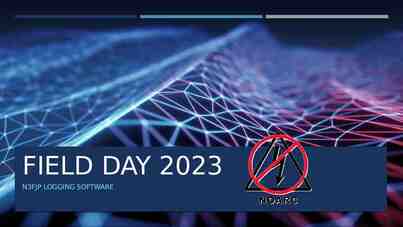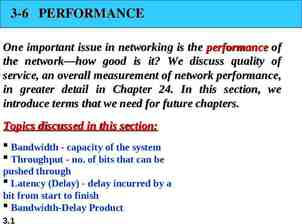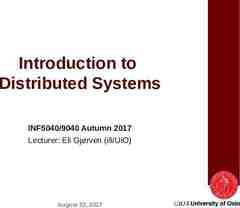Managing data
81 Slides3.48 MB

Managing data

Building Data Dynamic Web Sites Truly dynamic web sites Content changes over time Content customised for individual user Content automatically generated Content Programmatically generated Can be File system based HTML and Images stored on File System Gets hard to manage over time Database based HTML, Images etc all generated from database Easier to manage If data is too large, can overload the database

Database Structured collection of data. Tables Fields Query Reports Essentially a much more sophisticated implementation of the flat files.

Relational Database Stores data in separate tables instead of a single store. Relationships between tables are set In theory, this provides a faster, more flexible database system.

Example We wish to maintain a database of student names, IDs, addresses, and any other information. Will be updated frequently with new names and information. Will want to retrieve data based on some predicate. e.g, ‘give me the names of all Massey students who live in Albany’. Will want to update database with new information about students, not previously recorded. e.g., may decide we want to include IRD nos. Very difficult to manage using ‘flat file’ systems

Databases Fast, Efficient back end storage Easier to manage than file system based approach Relational Database structure Well developed theory and practise Multi-user capable Multithreaded, multiprocessor, sometimes cluster based systems Standards based queries Structured Query Language (SQL) (SQL

MySQL Database world's most popular open source database because of its consistent fast performance, high reliability and ease of use Open Source License:- free GNU General Public License Free to modify and distribute but all modification must be available in source code format Commercial:- not free Fully paid up professional support used by Google, Facebook Nokia, YouTube, Yahoo!, Alcatel-Lucent, Zappos.com, etc.

Basic Database Server Concepts Database runs as a server Attaches to either a default port or an administrator specified port Clients connect to database For secure systems authenticated connections usernames and passwords Clients make queries on the database Retrieve content Insert content SQL (Structured Query Language) is the language used to insert and retrieve content

Database Management System Manages the storage and retrieval of data to and from the database and hides the complexity of what is actually going on from the user. Database Database Managemen t Ssytem User MySQL is a relational database management system

Client: makes a request Client (browser) Web browser requests an Internet resource by specifying a URL and providing input via HTTP encoded strings GET hello.php HTTP/1.1 Host: www.massey.ac.nz:80 os Server Web server os Interne t Network Core

Server: responds Webserver supports HTTP. Server Web server My codes HTTP Client HTML MySQL Operating System Web browser TCP/IP Interne t PHP interpreter

Server: responds Interne t MySQL Server Operating System MySQL server could be anywhere in the world Web server My codes HTTP Client HTML Operating System Web browser TCP/IP Interne t PHP interpreter

MySQL can be controlled through a simple command-line interface; however, we can use phpMyAdmin as an interface to MySQL. phpMyAdmin is a very powerful tool; it provides a large number of facilities for customising a database management system.

Server: responds Webserver supports HTTP. Server Web server Client My codes HTTP HTML phpM yAdmin MySQ L Operating System Web browser TCP/IP Interne t PHP interpreter

A Quick Tour

Table: Customers (data)

Table: Products (data)

Table: Purchases (data)

Table: PurchaseProducts (data)

Database Design

In MySQL there are three main types : text number Date/Time.

CHAR(size) Holds a fixed length string (can contain letters, numbers, and special characters). The fixed size is specified in parenthesis. Can store up to 255 characters VARCHAR(size) Holds a variable length string (can contain letters, numbers, and special characters). The maximum size is specified in parenthesis. Can store up to 255 characters. Note: If you put a greater value than 255 it will be converted to a TEXT type TINYTEXT Holds a string with a maximum length of 255 characters TEXT Holds a string with a maximum length of 65,535 characters MEDIUMTEXT Holds a string with a maximum length of 16,777,215 characters LONGTEXT Holds a string with a maximum length of 4,294,967,295 characters ENUM(x,y,z,etc.) Let you enter a list of possible values. You can list up to 65535 values in an ENUM list. If a value is inserted that is not in the list, a blank value will be inserted.Note: The values are sorted in the order you enter them. You enter the possible values in this format: ENUM('X','Y','Z') http://www.w3schools.com/sql/sql datatypes.asp

TINYINT(size) SMALLINT(size) MEDIUMINT(size) INT(size) BIGINT(size) FLOAT(size,d) DOUBLE(size,d) DECIMAL(size,d) -128 to 127 normal. 0 to 255 UNSIGNED*. The maximum number of digits may be specified in parenthesis -32768 to 32767 normal. 0 to 65535 UNSIGNED*. The maximum number of digits may be specified in parenthesis -8388608 to 8388607 normal. 0 to 16777215 UNSIGNED*. The maximum number of digits may be specified in parenthesis -2147483648 to 2147483647 normal. 0 to 4294967295 UNSIGNED*. The maximum number of digits may be specified in parenthesis -9223372036854775808 to 9223372036854775807 normal. 0 to 18446744073709551615 UNSIGNED*. The maximum number of digits may be specified in parenthesis A small number with a floating decimal point. The maximum number of digits may be specified in the size parameter. The maximum number of digits to the right of the decimal point is specified in the d parameter A large number with a floating decimal point. The maximum number of digits may be specified in the size parameter. The maximum number of digits to the right of the decimal point is specified in the d parameter A DOUBLE stored as a string , allowing for a fixed decimal point. The maximum number of digits may be specified in the size parameter. The maximum number of digits to the right of the decimal point is specified in the d parameter http://www.w3schools.com/sql/sql datatypes.asp

DATE() A date. Format: YYYY-MM-DDNote: The supported range is from '1000-0101' to '9999-12-31' DATETIME() *A date and time combination. Format: YYYY-MM-DD HH:MM:SSNote: The supported range is from '1000-01-01 00:00:00' to '9999-12-31 23:59:59' TIMESTAMP() *A timestamp. TIMESTAMP values are stored as the number of seconds since the Unix epoch ('1970-01-01 00:00:00' UTC). Format: YYYY-MM-DD HH:MM:SSNote: The supported range is from '1970-01-01 00:00:01' UTC to '2038-01-09 03:14:07' UTC TIME() A time. Format: HH:MM:SSNote: The supported range is from '-838:59:59' to '838:59:59' YEAR() A year in two-digit or four-digit format.Note: Values allowed in four-digit format: 1901 to 2155. Values allowed in two-digit format: 70 to 69, representing years from 1970 to 2069 http://www.w3schools.com/sql/sql datatypes.asp

A Quick Tour

Create Database

Create Table: Customers

Specify the Table’s Fields & Attributes: Customers

Table Edit Screen: Customers

Table: Products

Table: Products

Insert Record: Customers

Table: Customers (data)

Insert Record: Products

Table: Products (data)

Edit Record

Export

Deleting a Table

Restoring a database from an SQL file

Database Design

Summary Concept of databases Tables and Fields Field Types phpMyAdmin Tool for manipulating databases Creation of a database How to add and edit records How to back-up a database Database Design

Connecting to a MySQL DBMS In order for our PHP script to access a database we need to form a connection from the script to the database management system. resourceId mysql connect(server, username, password); Server is the DBMS server username is your username password is your password

Connecting to a MySQL DBMS In order for our PHP script to access a database we need to form a connection from the script to the database management system. resourceId mysql connect(server, username, password); The function returns a resource-identifier type. a PHP script can connect to a DBMS anywhere in the world, so long as it is connected to the internet. we can also connect to multiple DBMS at the same time.

Selecting a database Once connected to a DBMS, we can select a database. mysql select db(databasename, resourceId); the resourceId is the one returned by mysql connect() the function returns true if the selection succeeded; false, otherwise.

Example: Connect to a DBMS and access database ?php dbLocalhost mysql connect("localhost", "root", "") or die("Could not connect: " . mysql error()); mysql select db("glassesrus", dbLocalhost) or die("Could not find database: " . mysql error()); echo " h1 Connected To Database /h1 "; ? die() stops execution of script if the database connection attempt failed. mysql error() returns an error message from the previous MYSQL operation.

Reading from a database We can now send an SQL query to the database to retrieve some data records. resourceRecords mysql query(query, resourceId); the resourceId is the one returned by mysql connect() the function returns a resource identifier to the returned data.

?php Example: Connect to a DBMS, access database, send query dbLocalhost mysql connect("localhost", "root", "") or die("Could not connect: " . mysql error()); mysql select db("glassesrus", dbLocalhost) or die("Could not find database: " . mysql error()); dbRecords mysql query("SELECT * FROM customers", dbLocalhost) or die("Problem reading table: " . mysql error()); echo " h1 Connected To Database /h1 "; ? the function will return a resource pointer (not the actual data) to all the records that match the query. If all goes well, this script will output nothing on screen.

Extract contents of one record We can now extract the actual data from the resource pointer returned by mysql query(). fieldData mysql result(resourceRecords, row, field); the resourceRecords is the one returned by mysql query() field – database field to return the function returns the data stored in the field. field

?php Example: Connect to a DBMS, access database, send query dbLocalhost mysql connect("localhost", "root", "") or die("Could not connect: " . mysql error()); mysql select db("glassesrus", dbLocalhost) or die("Could not find database: " . mysql error()); dbRecords mysql query("SELECT * FROM customers", dbLocalhost) or die("Problem reading table: " . mysql error()); strSurname mysql result( dbRecords, 0, "Surname"); echo " p strSurname /p "; ? the function will return a resource pointer (not the actual data) to all the records that match the query. If all goes well, this script will output a surname on screen.

SQL statement SELECT * FROM customers Go and obtain from the database every field FROM the customers table

Separating the database connection It is worth separating the database connectivity from our scripts and placing it in a separate file. It provides a convenient means of moving your scripts from one database platform to another.

Example: Separating the database connection ?php // File: database2.php strLocation "Home"; // strLocation "Work"; if ( strLocation "Home") { dbLocalhost mysql connect("localhost", "root", "") or die("Could not connect: " . mysql error()); mysql select db("glassesrus", glassesrus dbLocalhost) or die("Could not find database: " . mysql error()); } else { dbLocalhost mysql connect("localhost", "username", "password") or die("Could not connect: " . mysql error()); mysql select db("anotherdatabase", anotherdatabase dbLocalhost) or die("Could not find database: " . mysql error()); } ? strLocation could be easily switched between ‘Home’ or ‘Work’

Viewing a whole record To view the whole record returned from mysql query(), we need another function. array mysql fetch row(resourceRecords) resourceRecords – resource identifier returned from mysql query(). it returns an array containing the database record.

Example: Displaying all customer records ?php require once("database2.php"); dbRecords mysql query("SELECT * FROM customers", dbLocalhost) or die("Problem reading table: " . mysql error()); while ( arrRecord mysql fetch row( dbRecords)) { mysql fetch row echo " p " . arrRecord[0] . " "; echo arrRecord[1] . " "; echo arrRecord[2] . " "; echo arrRecord[3] . " /p "; } ? The function returns false when the last record is returned; thus, stopping the loop. Note, however, that the fields are referred to by using numbers – not very easy to read and mistakes can be introduced.

Limiting the records returned SELECT Surname FROM customers SELECT Surname FROM customers Retrieves only the Surname field from the table customers

Limiting the records returned SELECT * FROM customers LIMIT 3,4 SELECT * FROM customers LIMIT 3,4 Select a certain number of records form a table 3 is the starting row 4 is the number of records to be selected after the starting row

Searching for matching records SELECT * FROM customers WHERE SELECT * FROM customers WHERE Title ‘Mr’ The WHERE attribute specifies what to search for within the database records. in this example, only records which have a title of ‘Mr’ will be returned.

Searching for matching records SELECT * FROM customers WHERE SELECT * FROM customers WHERE Title ‘Mr’ OR Title ‘Mrs’ The WHERE attribute specifies what to search for within the database records. in this example, only records which have a title of ‘Mr’ or ‘Mrs’ will be returned. we can also use AND and OR to formulate more sophisticated conditions.

Searching for matching records SELECT * FROM customers WHERE SELECT * FROM customers WHERE Title ‘Mr’ AND Surname ‘Smith’ OR Title ‘Mrs’ The WHERE attribute specifies what to search for within the database records. in this example, only records which have a surname of ‘Smith and title of ‘Mr’ or the title of ‘Mrs’ will be returned. we can also use AND and OR to formulate more sophisticated conditions.

Sorting records The ORDER BY attribute can be used to sort the order in which records are obtained. SELECT * FROM cutomers ORDER BY Surname DESC the ORDER BY attribute is followed by the data field on which to sort the record DESC or ASC – from high to low, or from low to high Example15-12.php

Accessing Multiple Tables ?php // File: example15-13.php require once("database2.php"); dbRecords mysql query("SELECT * FROM customers WHERE Title 'Mrs'", dbLocalhost) or die("Problem reading table: " . mysql error()); echo " p Customers: /p "; while ( arrRecords mysql fetch array( dbRecords)) { echo " p " . arrRecords["Id"] . " "; echo arrRecords["Title"] . " "; echo arrRecords["Surname"] . " "; echo arrRecords["Firstname"] . " /p "; } //.continued. Example15-13.php

Accessing Multiple Tables //continuation. dbRecords mysql query("SELECT * FROM products WHERE Name 'Wine Glass'", dbLocalhost) or die("Problem reading table: " . mysql error()); echo " p Products: /p "; while ( arrRecords mysql fetch array( dbRecords)) { echo " p " . arrRecords["Id"] . " "; echo arrRecords["Name"] . " "; echo arrRecords["Description"] . " "; echo arrRecords["Quantity"] . " "; echo arrRecords["Cost"] . " /p "; } ? Example15-13.php

Using records to read another table Read a customer record, and then Read a customer record, and then show the products purchased by that customer. Tables Customers Products Purchases PurchaseProducts Example15-14.php

BIRD’S EYEVIEW Using records to read another table . strSurname "Jones"; Jones dbCustRecords mysql query("SELECT * FROM customers WHERE Surname ' strSurname' ",.) while ( arrCustRecords mysql fetch array( dbCustRecords)) { //#1 intId arrCustRecords["Id"]; //display customer’s details dbPurRecords mysql query("SELECT * FROM purchases WHERE customers Id ' intId'", .) while ( arrPurRecords mysql fetch array( dbPurRecords)) {//#2 intPurId arrPurRecords["Id"]; //display purchase date dbProRecords mysql query("SELECT * FROM purchaseProducts WHERE purchases Id ' intPurId' ",.) while ( arrProRecords mysql fetch array( dbProRecords)) { //#3 intProductId arrProRecords["products Id"]; //display Quantity dbProductRecords mysql query("SELECT * FROM products WHERE Id ' intProductId'",.) arrProductRecord mysql fetch array( dbProductRecords); //display product details } #3 } #2 } //#1 Example15-14.php

Complete version Using records to read another table ?php require once("database2.php"); strSurname "Jones"; Jones dbCustRecords mysql query("SELECT * FROM customers WHERE Surname ' strSurname' ", dbLocalhost) or die("Problem reading table: " . mysql error()); while ( arrCustRecords mysql fetch array( dbCustRecords)) { intId arrCustRecords["Id"]; echo " p Customer: "; echo arrCustRecords["Title"] . " "; echo arrCustRecords["Surname"] . " "; echo arrCustRecords["Firstname"] . " /p "; dbPurRecords mysql query("SELECT * FROM purchases WHERE customers Id ' intId'", dbLocalhost) or die("Problem reading table: " . mysql error()); Example15-14.php

Complete version Using records to read another table while ( arrPurRecords mysql fetch array( dbPurRecords)) { intPurId arrPurRecords["Id"]; echo " p Purchased On: "; echo arrPurRecords["Day"] . "/"; echo arrPurRecords["Month"] . "/"; echo arrPurRecords["Year"] . " /p "; dbProRecords mysql query("SELECT * FROM purchaseProducts WHERE purchases Id ' intPurId' ", dbLocalhost) or die("Problem reading table: " . mysql error()); while ( arrProRecords mysql fetch array( dbProRecords)) { intProductId arrProRecords["products Id"]; echo " p " . arrProRecords["Quantity"] . " "; dbProductRecords mysql query("SELECT * FROM products WHERE Id ' intProductId'", dbLocalhost) or die("Problem reading table: " . mysql error()); arrProductRecord mysql fetch array( dbProductRecords); echo arrProductRecord["Name"] . " (" . arrProductRecord["Description"] . ") at £"; echo arrProRecords["Cost"] . " each. /p "; } } } ? Example15-14.php Example15-14.php

Inserting records How to create new database records and insert them into a table? INSERT INTO table (field1, field2,.) VALUES (‘value1’, ‘value2’,.) Alternatively, we have a simplified syntax: INSERT INTO table VALUES (‘value1’, ‘value2’,.) dbProdRecords mysql query("INSERT INTO products VALUES ( ' ', 'Beer Mug', '600 ml Beer Mug', '100', '5.99')", dbLocalhost) Example15-15.php

Inserting records ?php // File: example15-15.php require once("database2.php"); dbProdRecords mysql query("INSERT INTO products VALUES ('', 'Beer Mug', '600 ml Beer Mug', '100', '5.99')", dbLocalhost) or die("Problem writing to table: " . mysql error()); dbProdRecords mysql query("SELECT * FROM products", dbLocalhost) or die("Problem reading table: " . mysql error()); while ( arrProdRecords mysql fetch array( dbProdRecords)) { echo " p " . arrProdRecords["Id"] . " "; echo arrProdRecords["Name"] . " "; echo arrProdRecords["Description"] . " "; echo arrProdRecords["Quantity"] . " "; echo arrProdRecords["Cost"] . " /p "; } Example15-14.php ? Example15-15.php

Deleting records How to delete database records from tables? DELETE FROM table WHERE field ‘value’ e.g. dbCustRecords mysql query("DELETE FROM customers WHERE Id '3'", dbLocalhost) Note: If you have a relational database, you should tidy-up the other tables, based o their connection with the record you’ve deleted. Example15-16.php

Deleting records How to delete database records from tables? DELETE FROM table This will delete all records from a table! Note: back-up your database first! Example15-17.php

Amending records How to modify the contents of an existing database record? UPDATE table SET field ‘value1’, field ‘value2’.WHERE field ‘value’ requires you to specify the table, the list of fields with their updated values, and a condition for selection (WHERE). Example15-18.php

Amending records ?php // File: example15-18.php require once("database2.php"); dbCustRecords mysql query("UPDATE products SET Description '250 ml Tall Glass' WHERE Id '6'", dbLocalhost) or die("Problem updating table: " . mysql error()); dbProdRecords mysql query("SELECT * FROM products", dbLocalhost) or die("Problem reading table: " . mysql error()); while ( arrProdRecords mysql fetch array( dbProdRecords)) { echo " p " . arrProdRecords["Id"] . " "; echo arrProdRecords["Name"] . " "; echo arrProdRecords["Description"] . " "; echo arrProdRecords["Quantity"] . " "; echo arrProdRecords["Cost"] . " /p "; } Example15-14.php ? Example15-18.php

Amending records How to modify the contents of an existing database record? UPDATE table SET field ‘value1’, field ‘value2’.WHERE field ‘value’ Another Example: dbCustRecords mysql query("UPDATE products SET Name 'Beer and Lager Glass' WHERE Name 'Beer Glass'", dbLocalhost) A number of records will be updated in this example. Example15-19.php

Counting the number of records How to count the number of records after running a query? dbProdRecords mysql query("SELECT * FROM products", dbLocalhost) or die("Problem reading table: " . mysql error()); intProductCount mysql num rows( dbProdRecords); you can also use the same function to determine if a record exists. Example15-20.php Example15-21.php

Select a substring How to count the number of records after running a query? SELECT * FROM products WHERE substring(Name,1,4) ‘Wine’ This will return all records from the products table where the first four characters in the name field equals ‘Wine’ Example15-22.php

End of Lecture











